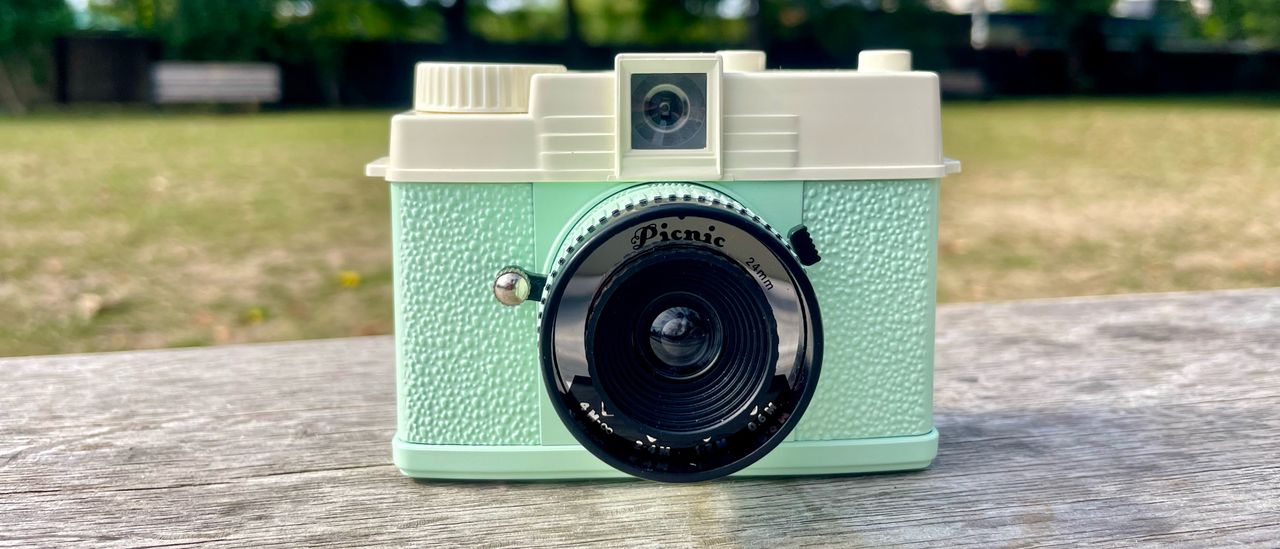**Two-Minute Review: Lomography Lomourette**
The Lomography Lomourette is a compact half-frame camera designed for the pure fun of film photography. Lightweight, inexpensive, and simple, it strips the analog shooting experience down to its creative essentials. Featuring a fixed f/8 plastic lens, manual focus dial, and a two-position shutter speed lever, it’s all about finding joy and beauty in imperfection.
In the hand, the Lomourette feels unmistakably like a toy camera. Its build borders on cheap with little refinement—there’s no aperture control or metering. What you get is a cheerful camera that encourages experimentation. For instance, the film advance wheel operates independently from the shutter release, enabling intentional or accidental double exposures.
Then there’s the half-frame format itself. Doubling the number of exposures from 36 to 72 on a standard 35mm roll, it allows you to shoot two vertical stills side-by-side within the space of a typical photo. This feature squeezes twice the entertainment out of your film.
—
**Design and Build Quality**
The Lomourette feels more like a toy than a serious photography tool, and that’s very much by design. Much like the original Diana camera from the 1960s, both its body and lens are plastic with no frills. It features some rounded detailing on top and a textured main body but overall lacks any premium feel.
It weighs next to nothing, and the assembly has a bargain-basement vibe—yet it somehow feels robust enough to survive tossed in the bottom of a family backpack. And if it doesn’t, the low price means you won’t lose sleep over it.
The controls are deliberately kept simple: a shutter speed lever toggles between normal (1/60 sec) and bulb (long exposures), with a shutter release lever on the right. On the front of the lens is a rotating dial offering four focus distances: 0.6m, 1-2m, 2-4m, and infinity. There’s no aperture control—the lens is fixed at f/8.
On top, you’ll find a mount for the detachable Diana+ flash attachment and a film advance wheel that operates independently from the shutter. This quirk allows for multiple exposures on the same frame but requires care to avoid unintentional overlays. The flash is powered by a single AA battery, with no exposure or intensity control—just on or off, accompanied by a ready indicator and test-fire option.
Some controls have quirks: the focus dial can be tricky to rotate, especially for larger fingers, as you need to twist the inner section of the lens rather than the more accessible outer edge. Loading film is fiddly too—the small teeth on the take-up spool may require several attempts to catch the film leader, and aligning the rewind lever properly is necessary to close the back panel.
The viewfinder is basic and not linked to the lens, making it easy to accidentally shoot with the lens cap on. It offers only a modest eye window and does not perfectly represent the framed scene, increasing the chance of framing errors.
—
**Performance**
Like many Lomography cameras, the Lomourette prioritizes feel over fidelity. Despite its plastic lens, many images it produces are real keepers.
Under bright daylight, it often delivers an attractive balance of realism and nostalgic character. Shadows and highlights show surprising depth, and colors appear natural, particularly skin tones. Shooting Kodak Ultramax 400 yielded stills with an honest, slightly warm and grainy look reflecting the genuine analog experience—not overly stylized or rose-tinted.
Though its 24mm lens doesn’t capture fine detail like higher-end cameras, it is sharper than expected. When focused properly, clean, defined edges emerge—text on clothing or rims of coffee cups stand out through the haze of film grain. Images have enough detail to crop half-frames for sharing or using as phone wallpapers.
Consistency is not its strong suit. Exposure varies wildly, especially with changing light—some shots appear washed out, others underexposed. Without a built-in light meter, you’ll need to judge exposure based on lighting conditions and film choice, with ISO 200 or 400 recommended for bright daylight. The 1/60 sec shutter speed is just fast enough for handheld shots outdoors, while indoors you’ll need to rely on the flash or bulb mode with a steady hand.
My hit rate was about 60%, with many frames lost due to exposure errors. However, even flawed shots showed artistic promise—overlapping frames produced unique layered compositions with shadows and light streaks crossing borders, adding a creative flair.
Focus adjustment, though fiddly and imprecise, functions adequately. Slight blurring and barrel distortion add to the camera’s lo-fi character, which suits its celebration of imperfection.
The biggest frustration was the flash. Although the detachable Diana+ flash brightened low-light indoor portraits well, it was inconsistent—sometimes refusing to fire despite the ready light indicating it was primed, resulting in wasted exposures.
—
**Should I Buy the Lomography Lomourette?**
**Buy it if:**
– You want a fun, low-cost film camera to experiment with and enjoy the analog process without pressure.
– You appreciate a camera that embraces happy accidents and creative imperfections.
– You’re new to film photography or seeking a playful, pocket-sized companion for casual shooting.
– You want to maximize the number of exposures per roll with the half-frame format.
**Don’t buy it if:**
– You’re after consistently sharp, perfectly exposed images.
– You require precise control over exposure or aperture.
– You want a durable professional-grade camera with advanced features.
– You dislike the occasional unpredictability or technical hiccups in your photos.
—
**Price and Availability**
The Lomography Lomourette is priced at $69 / £65 and is available now in multiple colorways through the Lomography website and other retailers. The Diana+ flash is bundled with the camera, along with colored gel filters.
—
**How I Tested the Lomography Lomourette**
I tested the Lomourette over two months, shooting 1.5 rolls of film in a variety of lighting conditions. To simulate regular use, I took it on family outings, using it indoors and outdoors. For a true test of its intuitiveness, I also let a six-year-old handle it.
I thoroughly explored every control and feature: loading and winding film, using the Diana+ flash, employing bulb mode for long exposures, and testing the focus dial’s impact on sharpness.
After developing and scanning the negatives, I carefully reviewed each frame for color accuracy, exposure consistency, and overall image quality.
This analytical yet hands-on approach provided a well-rounded view of the Lomourette’s real-world performance and creative potential.
—
**Conclusion**
Overall, the Lomography Lomourette is a refreshingly care-free camera that invites you to play with film and embrace unpredictability. It’s not for perfectionists but perfect for those who find joy in spontaneity and the unique charm of analog “happy accidents.” If you’re ready to dive into film photography with a playful tool that encourages experimentation, the Lomourette is a delightful choice.
https://www.techradar.com/cameras/compact-cameras/its-far-from-perfect-but-lomographys-cheap-lomourette-compact-camera-is-packed-with-grainy-lo-fi-analog-charm



